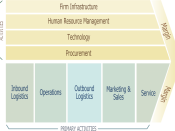Porter (2001) summarises the relative advantages of the Internet and how these are worthless without a strategic approach in his article. He uses his own five forces analysis to analyse the "underlying forces of competition" and states that this analysis is still necessary to "illuminate" areas of potential profitability for any company or in any industry. He suggests that using his value chain analysis should be the basis for exploration into areas in which the Internet can provide an advantage.
Strategy has clusters as is suggested in diagram one (adapted from Chaffey 2002:163). Chaffey uses Johnson and Scholes (1999) differing layers of strategy to compose this diagram. He places e-business strategy as supporting corporate strategy objectives and functional marketing and supply chain management strategies. The positioning of e-business strategy as central in the diagram supports Porter's (2001) comment that the "Internet actually makes strategy more essential than ever."
Johnson and Scholes (1999:1) provide an explanation "Corporate strategy is concerned with the overall purpose and scope of the organisation to meet the expectations of owners or major stakeholders and add value to the different parts". Strategic management is "the process of making and implementing strategic decisions" Beckinsale (2003). Porter (2001) suggests that in order to utilise the Internet effectively organisations must understand how to integrate its application into their existing strategy.
However, Tapscott (2001) argues that there is a fundamental transformation in the "basis for competitive strategy", due to the networking capabilities of the Internet. Hagel and Brown (2001:106) in their article 'Your next IT strategy' discuss the "traditional IT architecture" used by organisations which consisted of internal information systems which are built for the company and require in house IT specialists to keep them running. Sources of competitive advantage in the banking industry for example, have...


